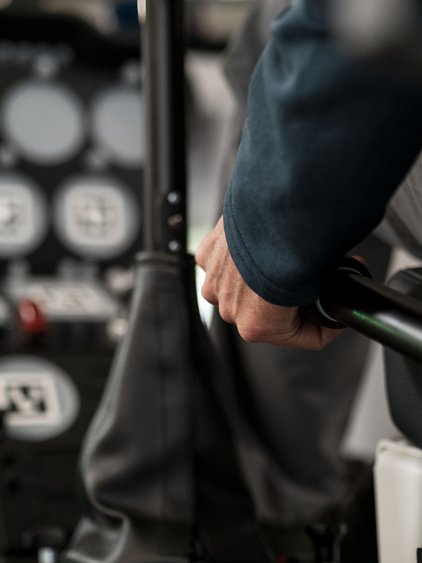World’s first qualified Virtual Reality Training Device allows time to be credited towards flight training.
New opportunities for pilots, flight schools and helicopter operators
Since the qualification of the training device is done directly by EASA, customers of VRM Switzerland can use the VR training device without further national qualification according to EASA regulations. This enables innovative companies to establish new business models and to increase flight safety using the latest technology, to offer more cost-effective training solutions and to train in an environmentally friendly way at any time of day. All this is possible because VRM Switzerland can operate the training devices worldwide with its own Flight Simulation Training Device Organization (FSTDO). This simplifies the organizational effort for flight schools and operators enormously. The qualified Robinson R22 and the soon to be qualified Airbus H125 simulators with sling load training option (HESLO) are available now. Fabi Riesen, CEO at VRM Switzerland says: «Pilots should receive realistic training on simulators. This allows helicopter operators and flight schools to fly more efficiently and safely. Thanks to the qualification from EASA, we can offer training with the possibility of crediting flight hours. To make this possible, a lot of preparatory work was necessary. The suitability of the VR concept was verified through a training evaluation program together with EASA involving pilots of various nationalities from industry and aviation authorities, including helicopter flight instructors and test pilots.» This evaluation confirmed the suitability of the VR concept for training purposes, particularly for cases such as autorotation, hovering and slope landing where exact height perception and a wide field of view are required.

Fabi Riesen
CEO VRM Switzerland

Varjo VR-3 enables the qualification of the VR training device
The professional use in aviation places high demands on hardware and software. «In the wide variety of VR headsets, Varjo’s latest product is the only device which met the requirements. The high-resolution display in particular was the reason for choosing this product» explains Fabi Riesen.
Seppo Aaltonen
Chief Commercial Officer Varjo

Creditable training time and other advantages
With the qualified FSTD, training time can be credited toward flight training courses. In the example of the R22, which is qualified as FNPT II, EASA allows 5 hours of credit for a PPL and 10 or 20 hours for a CPL(H), depending on the training concept. The trainee also receives 5 hours of credit for night flight training. Thus, the acquisition of a training solution can be worthwhile even for companies with a small number of flight students and pilots. Among other things, the simulator can be used to learn hovering and other basic maneuvers. Various emergency procedures, such as autorotations with landing and tail rotor failure, can be practiced. The system also allows scenarios that are not feasible or too dangerous with the real helicopter. Targeted training thus optimally promotes the pilots’ skills. David Solar, Head of General Aviation and VTOL Department at EASA points out:

David Solar
Head of General Aviation (GA) and Vertical Takeoff and Landing (VTOL) Department at EASA

Strong belief of commercial operators - Helitrans
Customers have already responded positively to the qualification of the simulator solution. Today the Norwegian company Helitrans has reserved two spots of the AS350/H125 out of the existing 15 qualification slots in 2021, and confirmed options for the R44, AW09, H135 and H145. This shows impressively that schools and professional operators have been waiting for a VR simulator solution for a long time, with which flight training can be improved and also simplified. The qualification now gives them the certainty that the investment will pay off.

Ole Christian Melhus
CEO/Accountable Manager at Helitrans, Norway’s largest inland domestic helicopter company
Professional simulator training, especially within special operations, will reduce risk and increase the standards and strengthen the safety culture as historically, most training, including type rating training, OPC/PCs, are done in the actual helicopter. Now, this training can be done in a safe and weather independent optimum learning environment, also increasing crew efficiency. With the realistic 3D VRM Switzerland visual & flight modulations, operators will also be able to train additional pilots to the highest HESLO levels, two pilot crew concepts including CRM and customize other special operations to their needs which would be challenging to achieve in the conventional full flight simulator environment. We are aligning our strategy based on this investment and are now planning to establish a new training center, open to all Nordic companies and customers. When qualified, we will expand our simulator fleet with the R44, AW09, H135/H145 and establish a comprehensive training and competency center. I am also extremely pleased to see the efforts of EASA supporting the drive to enhance rotorcraft safety through pursuing and supporting innovation and “out of the norm” training technology – impressive!

High Tech in Swiss Quality
A sophisticated overall system creates a full-body immersion. This gives the pilot the feeling of sitting in a real helicopter. The highly dynamic motion platform allows the pilot to precisely feel the finest changes in attitude and touchdown on the ground. A numerical simulation enables the realistic representation of the flight behavior. The cockpit is modeled on the real helicopter. The pilot’s movements are displayed in the VR environment, enabling operation of the cockpit including haptic perception. In addition, the software is optimized for VR glasses. This has the great advantage that the pilot has exactly the same visual representation as in the real helicopter, which is unique.

Christian Marty
CTO VRM Switzerland
About
VRM Switzerland is an innovative team of 30 passionate engineers, highly specialized developers and dedicated aviation experts. All mechanical designs and electronic circuits are designed and coordinated in-house. Another strength of the team is its proximity to flight schools and operators. The Swiss launching customers Mountainflyers, the Heli Academy, the development partner Air Zermatt, the helicopter manufacturer Kopter and other specialists enable the development of sophisticated training solutions with optimal benefits. www.vrm-switzerland.ch
Varjo makes revolutionary VR / XR hardware and software that together allow you to see virtual and augmented content just as clearly as you see the analog world around you. Varjo’s virtual and mixed reality headsets take you to another level of performance and emotional immersion – recreating the exact feeling and conditions of real life, enabling you to perform better and learn faster. Varjo is profoundly changing the way professionals work, train, design and collaborate across industries. www.varjo.com
Helitrans is Norway’s largest inland helicopter company with close to 100 employees, operating 23 helicopters within a range of special operations and have 9 bases spread out from the south to north above the arctic circle. Helitrans has placed a firm order for new 12 AW09 helicopters (previously SH09) with an option for up to six more. Helitrans AS was founded in 1990. www.helitrans.no


























